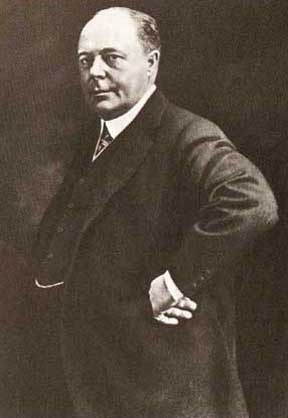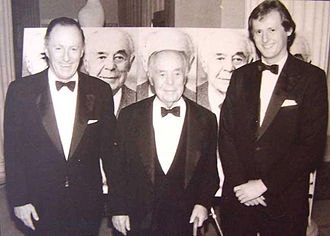Discover Your Roots
SIGN UPDiscover Your Roots
SIGN UPSeymour is a male given name of French origin, meaning "From The Village Of St. Maur." The name has a rich historical significance and has been borne by notable individuals across various fields. Some famous Seymours include Seymour Cray, the American supercomputer architect; Seymour Hicks, the British actor and playwright; and Seymour Papert, the South Africa-born American mathematician and educator. Additionally, Seymour is also associated with fictional characters such as Seymour Skinner from The Simpsons and Seymour Glass from J. D. Salinger's Glass Family series. This distinguished name has left its mark in both real-life achievements and fictional narratives, making it a name with a deep and diverse legacy.

Seymour Horace Knox I (1861 – 1915) was a successful businessman from Buffalo, New York, known for his involvement in the F. W. Woolworth Company. Born in Russell, St. Lawrence County, New York, he ventured into teaching and later partnered with his cousins to establish the Woolworth & Knox store in Reading, Pennsylvania, in 1884. This marked the beginning of his successful career in the retail business. Knox continued to expand his ventures, opening several stores, and eventually, in 1911, the F. W. Woolworth Company was incorporated, with Knox becoming a significant figure in the corporation. In his personal life, Knox married Grace Millard, with whom he had four children. His grandson, Seymour H. Knox III, became known as one of the principal owners of the Buffalo Sabres in the National Hockey League. Seymour Horace Knox I passed away in 1915, leaving behind a legacy of entrepreneurial success and a prominent family lineage.

Seymour Horace Knox III was an influential American philanthropist and sports entrepreneur, best known for owning the Buffalo Sabres of the National Hockey League from their foundation in 1970 until his passing in 1996. Born in 1926 in Buffalo, New York, Seymour was the grandson of Seymour H. Knox I, co-founder of the F.W. Woolworth Company, and son of art enthusiast Seymour H. Knox II. He served in World War II before embarking on a successful career as a Vice President at Dominick & Dominick Inc. Notably, Seymour's efforts, alongside his brother and attorney, led to the establishment of the Buffalo Sabres, and he played a pivotal role in the team's success, earning recognition as The Hockey News executive of the year in 1975. In addition to his contributions to the sports world, Seymour was a dedicated philanthropist, supporting various Greater Buffalo charities and causes. His legacy lives on through his induction into the Greater Buffalo Sports Hall of Fame and the Buffalo Sabres Hall of Fame. Seymour Horace Knox III passed away on May 22, 1996, leaving behind a lasting impact on the sports community and his philanthropic endeavors.

Seymour Horace Knox II (1898–1990) was a Buffalo, New York, philanthropist, and accomplished polo player. Born into wealth, he followed his father's business footsteps and made significant contributions to the arts and culture scene in Buffalo and beyond.After graduating from Yale University in 1920, Knox embarked on a successful career, serving as a director and chairman of various renowned institutions, including Marine Midland Bank and F. W. Woolworth Company. His passion for the arts led him to join the board of Albright Art Gallery, where he played a pivotal role in promoting modernism and significantly expanded the gallery's collection. Knox's generous donations included over 160 works to the Albright-Knox Art Gallery, with notable contributions to the popularity of artists like Jackson Pollock.In his personal life, Knox married Helen Northrup and had two sons, both of whom became principal owners of the Buffalo Sabres NHL team. His dedication to the arts was recognized when he was awarded the National Medal of Arts in 1986 by President Ronald Reagan.Knox's legacy lives on through the Seymour H. Knox Jr., Curator of Modern and Contemporary Art positions at Yale University Art Gallery, and the Albright-Knox Art Gallery, which was renamed in his honor after his significant contributions. He passed away in 1990, leaving behind a remarkable impact on the art world and the city of Buffalo.

Seymour MacDonald Nurse, born on November 10, 1933, was a Barbadian cricketer known for his powerful batting and aggressive shot-making. He played 29 Test matches for the West Indies between 1960 and 1969, making a significant impact in international cricket. Nurse, a relative latecomer to high-level cricket, struggled initially to establish himself in the West Indies team but found his groove during the West Indies tour of England in 1966. Subsequently, he retired from Test cricket at the peak of his powers, leaving behind a remarkable legacy. Nurse's last Test innings of 258 remains the highest score by a cricketer in his final Test innings.Born in Saint Michael, Barbados, Nurse's early life was marked by a passion for both football and cricket. However, a severe leg injury led him to focus solely on cricket, a decision that proved pivotal for his future. Nurse's journey to professional cricket began in the Barbados Cricket League, eventually leading him to join the famous Empire Cricket Club, where he met his mentor, Everton Weekes. His playing style was characterized by forceful strokeplay, aggressive batting, and occasional off-spin bowling. Nurse's contributions to cricket were recognized when he was named a Wisden Cricketer of the Year in 1967.Beyond his playing career, Nurse continued to be involved in cricket, managing and coaching the Barbados team and serving as the head coach of the Barbados National Sports

Seymour Jonathan Singer (May 23, 1924 – February 2, 2017) was an esteemed American cell biologist and professor emeritus at the University of California, San Diego. Born in New York City, Singer earned his B.A. from Columbia University and later completed his doctorate at the Polytechnic Institute of Brooklyn. Notably, during his postdoctoral tenure at Caltech, he co-discovered the basis of abnormal hemoglobin in sickle-cell anemia. Singer's illustrious career included serving as a faculty member at Yale University and later joining the University of California, San Diego. He made significant contributions to the field of molecular and cellular biology, particularly in membrane protein conformation and the interaction between the cytoskeleton and the cell membrane. Singer's groundbreaking work led to the development of the "Fluid Mosaic Model" of the cell membrane, which was published in Science in 1972. His exceptional contributions were recognized through numerous accolades, including being elected to prestigious institutions like the National Academy of Sciences and the American Academy of Arts and Sciences. In 2001, he authored the book "The Splendid Feast of Reason," delving into rationalism and the philosophy of science. Singer's remarkable legacy continues to inspire and shape the scientific community.
All images displayed on this page are sourced from Wikipedia or Wikimedia Commons.We use these images under their respective Creative Commons or public domain licenses. Wherever applicable, author attributions and license information are provided. If you believe an image is used incorrectly or outside its license terms, please contact us so that we can review and correct the issue.